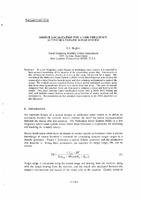| dc.contributor.author | Hughes, E. S. | |
| dc.date.accessioned | 2018-10-11T14:05:44Z | |
| dc.date.available | 2018-10-11T14:05:44Z | |
| dc.date.issued | 1993/08 | |
| dc.identifier | 804 | |
| dc.identifier.govdoc | CP-42/2 | |
| dc.identifier.uri | http://hdl.handle.net/20.500.12489/137 | |
| dc.description.abstract | In a low frequency active bistatic or multistatic sonar system, it is essential tohave accurate knowledge of the location of the transmitting source ship. Inaccuracies inthis information translate directly to errors in the range calculation for a target. Thefunction of the Multistatic Sonar System's (MSS) Direct Blast Processor is to localize thesource after a direct blast has been detected, and then to initiate and maintain a track of thesource. The method involves matched filtering a linear period modulated waveform, using data from three hydrophones located in a towed three line array. The time of arrivalscomputed from the matched filters arc then used to compute a range and bearing to thesource. This paper presents source localization results from a recent MSS bistatic seatrial, and includes source bearing accuracies as a function of source position and theenvironment. Recommendations for potential improvements to the MSS algorithm arcalso discussed. | |
| dc.format | 21 p. : ill. ; 24 fig. ; digital, PDF file | |
| dc.language | English | |
| dc.publisher | NATO. SACLANTCEN | |
| dc.source | In: Low frequency active sonar (SACLANTCEN Conference Proceedings CP-42), vol. 2, 1993, pp. D/16-1 - D/16-21. | |
| dc.subject | Low Frequency Active Sonar (LFAS) | |
| dc.subject | Multistatic sonar | |
| dc.subject | Acoustical sources | |
| dc.subject | Target localization | |
| dc.subject | Matched filtering | |
| dc.title | Source localization for a low frequency active multistatic sonar system | |
| dc.type | Papers and Articles | |
| dc.type | Conference Proceedings (CP) | |
